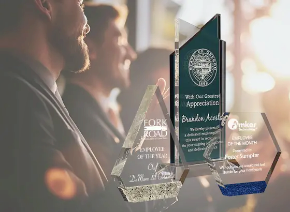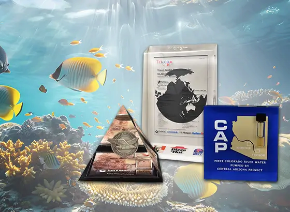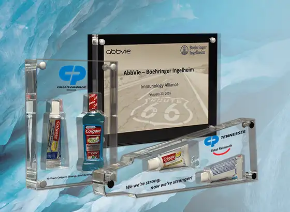
Recognizing excellence has been common throughout the history of the world.
In fact, the word ‘Trophy’ is derived from the Greek word ‘Tropaion’ which was a way of celebrating an ancient victory such as a battle.
To signify success over one's foes, the ancient Greeks, and later the Romans, would hang up the armor of the defeated foe as a symbol of victory.
Though the Greeks leaned towards erecting a memorial on the battlefield, the Romans chose to display their victories publicly by constructing monuments of marble and stone to stand for ages to boast of their wins to everyone who lived in and visited Rome.
One that still stands today is the Trajan’s Column in Rome – a monument that was erected in the second century (113 A.D.) by the Emperor Trajan to commemorate his dominance over the Dacians in what is today modern Romania.

 Stepping back to the ancient Olympic Games (776 B.C.) – prizes were not in the form of a trophy or medal, but rather a twisted olive branch was used and made into a crown or ‘Kotinos’ as they referred to it.
Stepping back to the ancient Olympic Games (776 B.C.) – prizes were not in the form of a trophy or medal, but rather a twisted olive branch was used and made into a crown or ‘Kotinos’ as they referred to it.
The wild olive tree had a broad history of religious significance for the ancient Greeks and thus was used as a symbol of dominance. Only the winner was recognized in the ancient games and no other awards were presented for runner up or just showing up.
There is very little documentation of trophies or awards during the middle ages.
However, shortly after the period there is history of a set of sterling silver bells presented in late 1599 during the Carlisle Bells, a historic British flat horse race between two competing towns. These bells are now held in the Carlisle Guildhall Museum in Northwest England.
It’s these symbols of victory that have over the ages morphed into what we in the west now refer to as Trophies.
For instance, during the late 1600’s smaller versions of the Greek and Roman Amphoras (a tall ancient Greek or Roman jar with two handles and a narrow neck) were documented as being presented as prizes for placing in sports competitions.

This shape, now referred to as a chalice cup, has been used as a dominant, engravable trophy style for centuries.
 Jumping ahead to the late 1800’s, in 1896 when the modern Olympic Games were first established medals were awarded to the winners.
Jumping ahead to the late 1800’s, in 1896 when the modern Olympic Games were first established medals were awarded to the winners.
However, these were not gold, silver, or bronze as we’re used to seeing today – but instead a silver medal and a Kotinos crown.
It wasn’t until 1904 when today’s traditional set of gold, silver, and bronze medals were presented in the Olympic Games held in St. Louis, Missouri.
Many famous sporting events over the years have and continue to use a metal chalice cup (often sterling silver) as a prize to present to the winner of the event.
Some examples are the Stanley Cup (hockey), the Dallah Trophy (golf), the Emperor’s Cup (sumo wrestling), the America’s Cup (sailing), the Grey Cup (football), the Costa del Sol Tropheo (soccer), the Borg-Warner Trophy (car racing), and the Kolanka Cup (polo).
Today, trophies take many forms such as traditional chalice cups, engraved plaques, glass pillars, acrylic shapes, medals, and figurines to signify sports prowess.
The transformation mentioned above to the metal chalice cup introduced the opportunity for craftsmen to inscribe with hand tools the pertinent information onto the cup directly into the polished metal surface.
We use the word ‘inscribe’ above as a reference to what we refer to today as engraving. Engraving has been the dominant way for humans to document and communicate for over 500,000 years as proven by stone carvings found in the Serengeti Plains of Africa.
For over half a million years, humans have found it not only to be the best way of documenting history, but also an art form that has been used to decorate walls, gemstones, bones, weapons, jewelry, swords, and modern day recognition awards presented for high performance.




The process of engraving awards has morphed over the years from a process of inscribing with hand tools to modern equipment that can mark metals, glass, acrylic, and wood with very little effort.
Though we go deep into the history of engraving techniques in our article ‘The Mark of Excellence’ – let’s take a quick look at the changes that have taken place over the past 50+ years in the trophy and engraving industry.
Developed in the late 1800’s a process called pantograph engraving used simple parallelogram linkage to transfer images to metal by tracing indented tiles or an image into the surface to be engraved.

Trophy typewriters were the first introduction to the industry at the very beginning of the computer age. A quick and easy way to duplicate information, the Automark Trophy Typewriter allowed the operator to simply type from a keyboard and have the letters embossed into the metal surface.

As microchips became the standard, so too did the technology that was introduced to the trophy and awards industry.
During the early 1980’s, a small company ‘Dahlgren Engraving Systems’ developed a computerized engraving system that used CAD (computer aided design) to engrave into metals and plastics.
The Dahlgren System 300, pictured below was the beginning of a new era in trophy manufacturing as it allowed for fast engraving on trophies, plaques, and medallions.

As technology has progressed over the past 50 years, high speed laser engraving technology has become the dominant way of engraving awards.
Laser engravers have allowed skilled computer graphic artists to translate their work into materials such as aluminum, copper, brass, stainless steel, plastics, acrylics, wood, glass, stone, leather, and ceramics – just to name a few.
Half a million years of communicating through the art form of inscribing a substrate has produced what we call today an engraved award.
US Acrylic Awards is one of the oldest and most respected trophy companies in the United States with a manufacturing facility located in Glendale Arizona. Our highly skilled craftsmen have well over 200 years of combined experience in engraving awards with the use of high speed lasers.
And unique to our engraved award experience is our ability to embed items directly into cast Lucite® with a combination of full color imprinting combined with engraving to create one-of-a-kind deal toys, trophies, plaques, and medals that set the standard for quality and creativity.
Have an idea? Give our team a call and allow ‘US’ Acrylic Awards to work our magic.
Written by noptim… unleash the power







